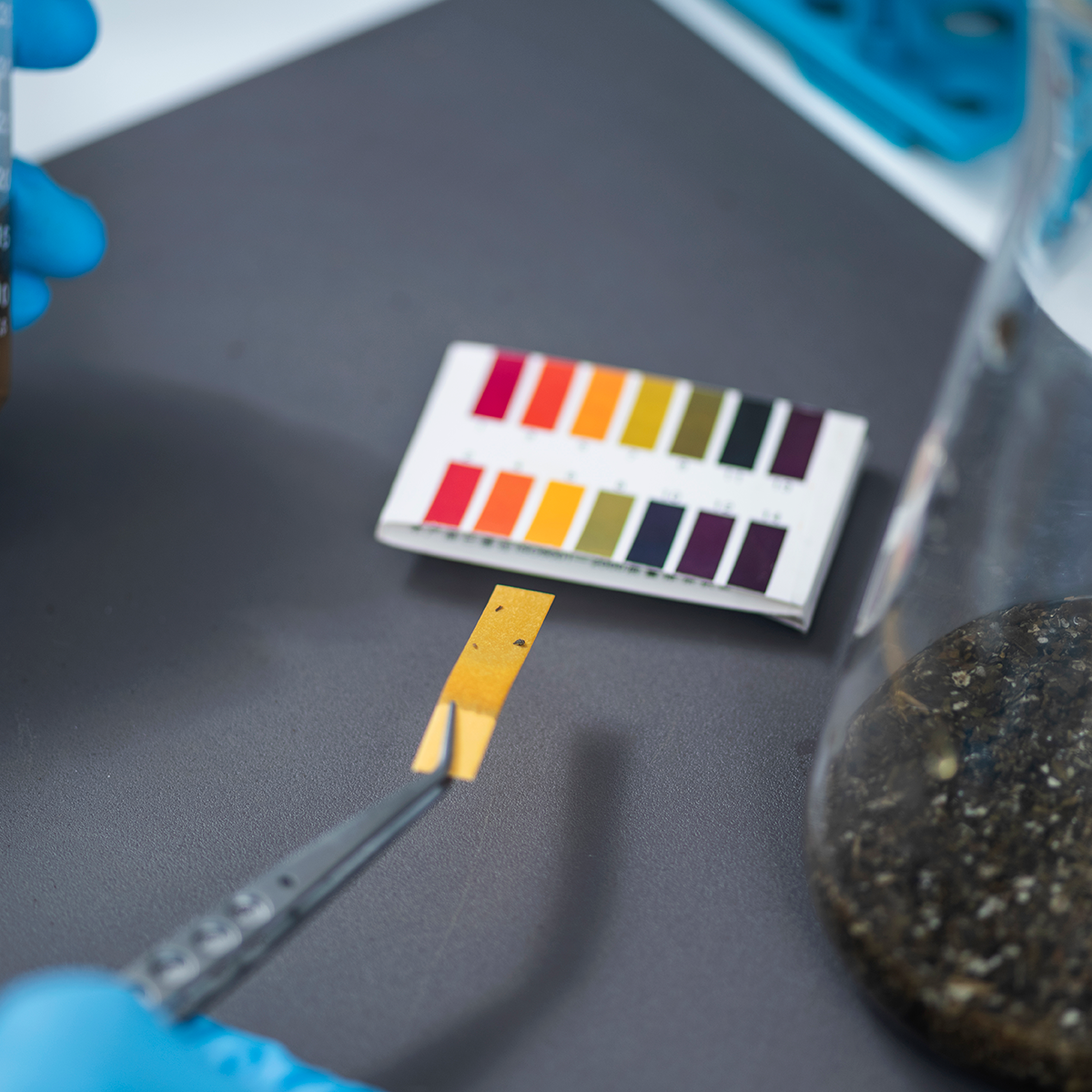Skin's pH Balance - Why it's crucial and How to Maintain it Naturally

Taking care of our skin isn’t just about avoiding dry patches or excessive oiliness. It’s also very much about understanding our skin’s pH balance and why it’s so essential for overall skin health. In this article, we’ll take a closer look at how pH levels differ across various areas of the skin, how and why pH can become imbalanced and what that means for the skin’s microbial diversity, and how the skin’s own endocannabinoid system can play a role in regulating this. We’ll also share three lifestyle tips to support naturally balanced skin.
What Is pH and Why Is It Important for the Skin?
pH is a scale that measures how acidic or alkaline a substance is. The scale ranges from 0 to 14, where 7 is neutral, below 7 is acidic, and above 7 is alkaline. The skin’s surface is naturally slightly acidic, typically between 4.5 and 5.5. This acidity forms part of what’s called the acid mantle, which helps protect the skin from pathogenic microorganisms, among other things.
Why is this acidity so important? Because the skin’s surface is home to a variety of microorganisms—both beneficial and less beneficial bacteria, fungi, and other microbes. Together, they form a skin flora or microbiome that, when balanced, helps protect the skin and keep it healthy. When the pH is out of balance, harmful bacteria can take over while beneficial bacteria weaken. This can lead to various skin issues like acne, eczema, and general irritation.
Different Skin Areas – Different pH Levels
Although the skin generally has a pH level of around 4.5–5.5, it varies slightly depending on where on the body you measure. The body isn’t a uniform surface; different areas have different conditions:
1. Face: The face, especially the T-zone (forehead, nose, and chin), can sometimes have slightly higher sebum production and a marginally higher pH than, say, the cheeks or neck. Still, it typically stays in the acidic range of 4.5–5.5 to protect this sensitive skin from acne-causing bacteria.
2. Body Folds (e.g., Armpits, Groin): These areas can often become warmer and moister, which can affect pH balance. Armpits tend to have a slightly higher pH, sometimes approaching just under 6, due to sweat and other factors. They also have more sweat glands and a higher density of bacteria that thrive in warm, damp environments.
3. Hands and Feet: Hands washed frequently can dry out, and their natural acid mantle can be easily disrupted. Using soap with a high pH can make hands more alkaline, leading to dryness and cracks. Feet, on the other hand, sweat more, and their pH is influenced by both foot sweat and footwear—some parts may be more acidic to fend off fungi and bacteria.
4. Other Body Parts: Generally, the skin on the torso, back, and legs has a fairly consistent pH structure, but differences can arise depending on skin type, sweating, and hair growth (e.g., on the back or legs).
What unites all these areas is that for the skin’s pH to function optimally, it should remain slightly acidic to maintain a balanced microflora and a strong skin barrier.
What Happens When pH Is Disrupted?
When the skin’s pH shifts too far toward the alkaline side—for instance, due to excessive use of harsh soaps or cleansers—the skin’s natural protective barrier breaks down. This causes the skin to lose moisture more quickly and makes it easier for bacteria and fungi to take hold. This can show up as:
- Dryness and Irritation: When the skin becomes too alkaline, it dries out faster, leading to itchy or flaky patches.
- Weakening of Microbial Diversity: Prolonged pH disruption can reduce beneficial bacteria while allowing less desirable microorganisms to dominate.
- Increased Risk of Acne, Eczema, and Other Conditions: A disrupted pH makes the skin more vulnerable to inflammation and infections. People with acne-prone skin often notice flare-ups when the skin barrier weakens.
While overly acidic environments can also irritate the skin, this is less common in everyday scenarios. Typically, alkaline products are the culprits, as many traditional soaps and some cleansers have a pH of 8–10, far higher (more alkaline) than the skin’s natural level.
Microbial Diversity – The Key to Healthy Skin
One of the most critical factors for skin health is its microbial diversity. The skin is our outer shield against the world, covered with various bacteria and fungi living in symbiosis. When everything is balanced, these microorganisms:
1. Combat Harmful Microbes: Good bacteria outcompete the bad ones.
2. Regulate the Immune System: The skin flora calms the immune response, reducing inflammation risks.
3. Preserve the Skin Barrier: Beneficial microbes produce lactic acid and other acids to keep the skin’s pH at the right level.
If we constantly expose the skin to harsh, alkaline cleansers and neglect proper moisturizing or care, this natural flora can weaken. Think of it like the gut flora in your stomach—many already know its importance for well-being. Similarly, skin flora is fundamental for healthy, glowing skin.
The Skin’s Endocannabinoid System and Its Role in pH
You might know the body’s endocannabinoid system (ECS) from its links to stress, pain management, or hunger. But the ECS is far more complex, and the skin is no exception. The skin’s ECS includes receptors and ligands (endocannabinoids) that regulate functions like:
- Sebum production
- Keratinocyte proliferation (skin cell renewal)
- Inflammation
- Skin barrier function
How does this tie into pH? The ECS helps balance the skin’s overall functions and influences how it responds to external stimuli. When the ECS is off-balance, sebum production can become too high or too low, leading to pH imbalances like excess oiliness, acne, or dryness. Inflammatory conditions like eczema or redness can also worsen if the ECS isn’t working optimally.
Research suggests that topical products with cannabinoids (e.g., CBD) can calm the skin by reducing inflammation and supporting the natural barrier. A stronger barrier and less inflammation improve the odds of maintaining a healthy pH range.
Three Lifestyle Tips to Maintain the Skin’s Natural pH
1. Use Gentle Cleansers and the Right Products
- Choose a pH-balanced makeup remover close to the skin’s natural pH (around 5.0–5.5).
- Avoid overly hot showers and harsh scrubbing, which can damage the skin’s protective layers and disrupt pH.
- Opt for skincare products that support microbial diversity and the endocannabinoid system.
2. Promote a Balanced Lifestyle for Hormonal Health
- Stress and hormonal imbalances can hit the skin hard. Elevated cortisol from stress affects sebum production and, in turn, pH. Managing stress with relaxation, meditation, or exercise can indirectly improve skin health.
- Sleep is vital for recovery and keeping the ECS balanced. Seven to eight hours nightly benefits the whole body, especially the skin.
- Maintain a healthy diet rich in fresh vegetables, fruits, whole grains, and quality proteins. Adequate vitamins (A, C, D, E) and minerals (zinc, selenium) support the skin barrier and indirectly influence pH through better overall health.
3. Listen to Your Skin’s Signals and Adjust Routines
- Introduce new products gradually and monitor how your skin reacts. Adding one at a time helps you determine what works.
Maintaining the skin’s pH balance is a cornerstone of good skin health. The skin’s natural pH of 4.5–5.5 preserves a rich microbial diversity that protects against harmful bacteria and issues like acne, eczema, and dryness. Different body areas may have slightly varying pH levels, but all rely on healthy acidity for an intact barrier and thriving microbiome.
When we use harsh cleansers or products with a high (more alkaline) pH, we risk upsetting this delicate balance, leaving the skin dry, sensitive, and prone to infections and inflammation. Meanwhile, the skin’s endocannabinoid system plays an intriguing role in regulating sebum, inflammation, and barrier function—indirectly affecting how well the skin maintains its natural pH.
By choosing gentle, pH-balanced cleansers, nurturing overall health (through sleep, stress management, and a nutritious diet), and staying attuned to the skin’s signals, we can holistically support its natural functions. Think of skincare as part of a broader lifestyle where sleep, diet, stress, and product choices all interplay.
Your skin deserves a balanced daily life. With the right conditions—gentle products and a sustainable lifestyle—it’s more likely to glow with health. Understanding and nurturing the skin’s pH balance isn’t just a trendy tip; it’s a fundamental step toward long-term, thriving skin. So let your skin rest in its naturally acidic environment and enjoy how much a balanced barrier can do for your outer (and inner) well-being.




Comments